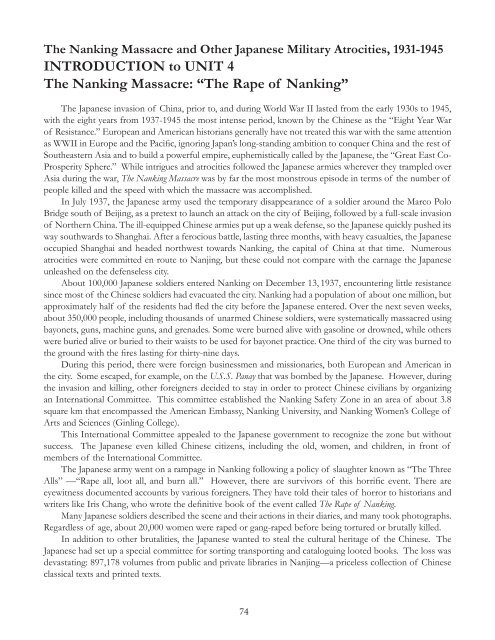Download - Canada ALPHA
Download - Canada ALPHA
Download - Canada ALPHA
Create successful ePaper yourself
Turn your PDF publications into a flip-book with our unique Google optimized e-Paper software.
The Nanking Massacre and Other Japanese Military Atrocities, 1931-1945<br />
INTRODUCTION to UNIT 4<br />
The Nanking Massacre: “The Rape of Nanking”<br />
The Japanese invasion of China, prior to, and during World War II lasted from the early 1930s to 1945,<br />
with the eight years from 1937-1945 the most intense period, known by the Chinese as the “Eight Year War<br />
of Resistance.” European and American historians generally have not treated this war with the same attention<br />
as WWII in Europe and the Pacifi c, ignoring Japan’s long-standing ambition to conquer China and the rest of<br />
Southeastern Asia and to build a powerful empire, euphemistically called by the Japanese, the “Great East Co-<br />
Prosperity Sphere.” While intrigues and atrocities followed the Japanese armies wherever they trampled over<br />
Asia during the war, The Nanking Massacre was by far the most monstrous episode in terms of the number of<br />
people killed and the speed with which the massacre was accomplished.<br />
In July 1937, the Japanese army used the temporary disappearance of a soldier around the Marco Polo<br />
Bridge south of Beijing, as a pretext to launch an attack on the city of Beijing, followed by a full-scale invasion<br />
of Northern China. The ill-equipped Chinese armies put up a weak defense, so the Japanese quickly pushed its<br />
way southwards to Shanghai. After a ferocious battle, lasting three months, with heavy casualties, the Japanese<br />
occupied Shanghai and headed northwest towards Nanking, the capital of China at that time. Numerous<br />
atrocities were committed en route to Nanjing, but these could not compare with the carnage the Japanese<br />
unleashed on the defenseless city.<br />
About 100,000 Japanese soldiers entered Nanking on December 13, 1937, encountering little resistance<br />
since most of the Chinese soldiers had evacuated the city. Nanking had a population of about one million, but<br />
approximately half of the residents had fl ed the city before the Japanese entered. Over the next seven weeks,<br />
about 350,000 people, including thousands of unarmed Chinese soldiers, were systematically massacred using<br />
bayonets, guns, machine guns, and grenades. Some were burned alive with gasoline or drowned, while others<br />
were buried alive or buried to their waists to be used for bayonet practice. One third of the city was burned to<br />
the ground with the fi res lasting for thirty-nine days.<br />
During this period, there were foreign businessmen and missionaries, both European and American in<br />
the city. Some escaped, for example, on the U.S.S. Panay that was bombed by the Japanese. However, during<br />
the invasion and killing, other foreigners decided to stay in order to protect Chinese civilians by organizing<br />
an International Committee. This committee established the Nanking Safety Zone in an area of about 3.8<br />
square km that encompassed the American Embassy, Nanking University, and Nanking Women’s College of<br />
Arts and Sciences (Ginling College).<br />
This International Committee appealed to the Japanese government to recognize the zone but without<br />
success. The Japanese even killed Chinese citizens, including the old, women, and children, in front of<br />
members of the International Committee.<br />
The Japanese army went on a rampage in Nanking following a policy of slaughter known as “The Three<br />
Alls” —“Rape all, loot all, and burn all.” However, there are survivors of this horrifi c event. There are<br />
eyewitness documented accounts by various foreigners. They have told their tales of horror to historians and<br />
writers like Iris Chang, who wrote the defi nitive book of the event called The Rape of Nanking.<br />
Many Japanese soldiers described the scene and their actions in their diaries, and many took photographs.<br />
Regardless of age, about 20,000 women were raped or gang-raped before being tortured or brutally killed.<br />
In addition to other brutalities, the Japanese wanted to steal the cultural heritage of the Chinese. The<br />
Japanese had set up a special committee for sorting transporting and cataloguing looted books. The loss was<br />
devastating: 897,178 volumes from public and private libraries in Nanjing—a priceless collection of Chinese<br />
classical texts and printed texts.<br />
74


